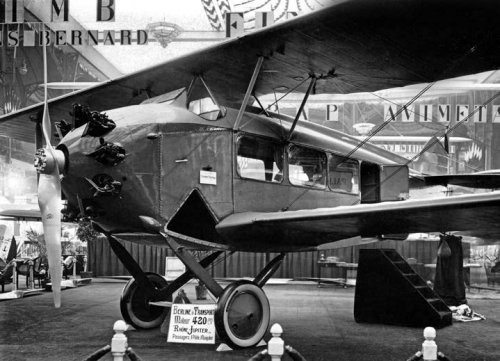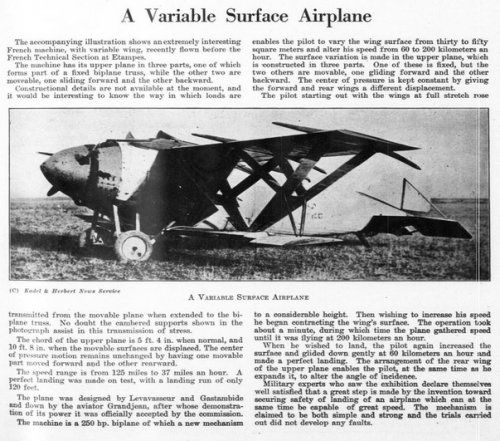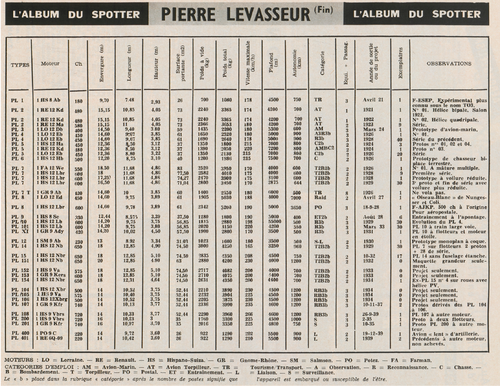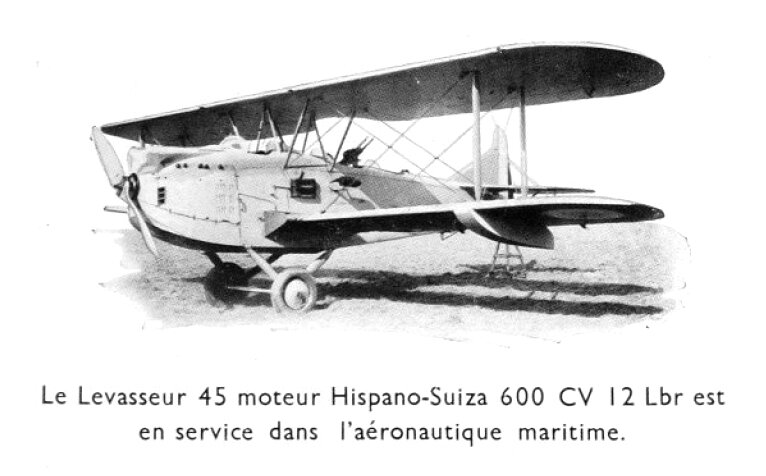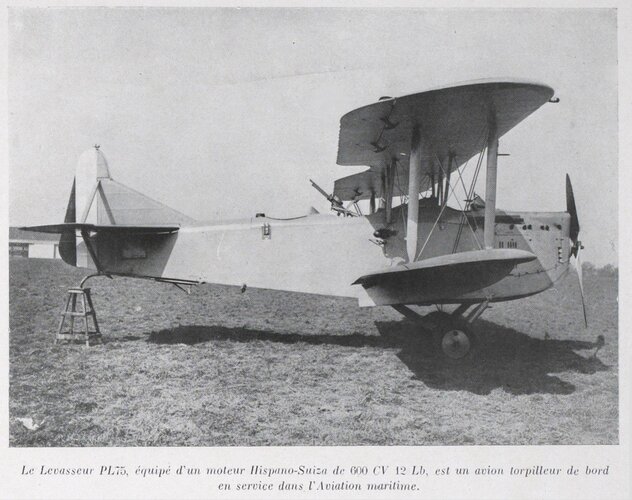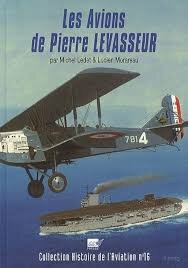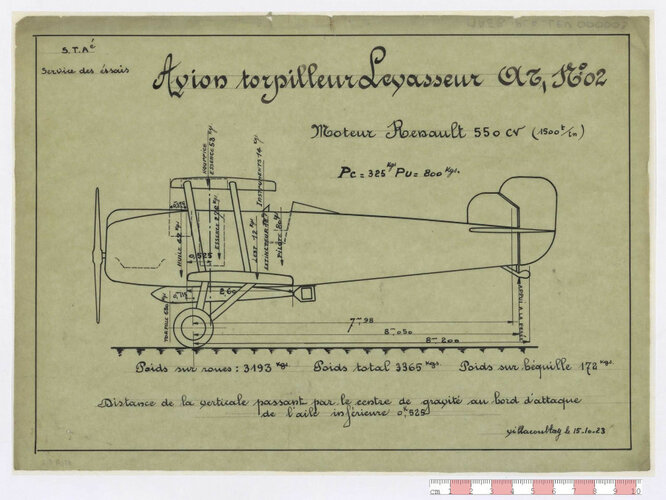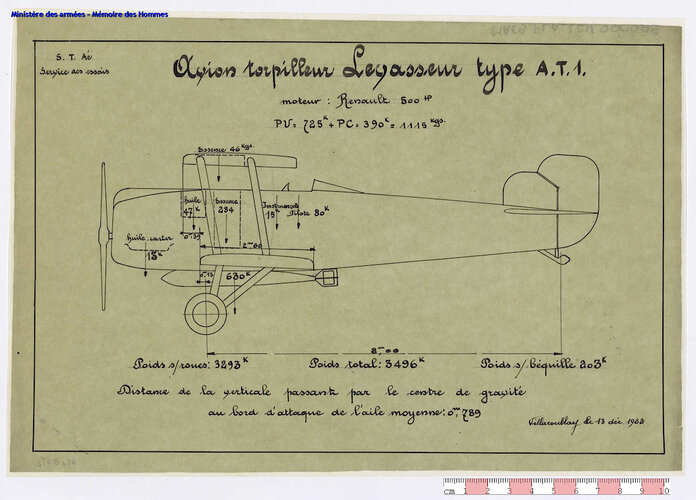- Joined
- 28 January 2008
- Messages
- 635
- Reaction score
- 512
Pierre Levasseur was a French aircraft designer born in 1871.
His company was called Sociéte Pierre Levasseur Aéronautique and thay produced aircraft mainly for the French Navy in the inter-war period. As a subsidiary, Levasseur also ran a successful flying school. The chief pilot of his school was François Denhaut who designed one of the first first flying boats.
Georges Abrial a French aerodynamicist, also worked with Levasseur to produce the Levasseur-Abrial A-1.
The LB designs by Jean Biche had the first example built by Constructions Aéronautiques J Levy and production machines by Etablissements P. Levasseur.
Levasseur Landeroin-Robert Monoplan
1913
Three-seat experimental triple wing monoplane with distinctine rollover frame-come forward wing support.
Levasseur-Abrial A-1
1922
High-wing monoplane glider.
Levasseur-Biche (Levy-Biche) LB 2
1925
Single-seat single bay sesquiplane fighter. At least one fitted with floats. 21 built in total with twenty production Levasseur examples designated LB 2 AMBC1.
see also http://www.secretprojects.co.uk/forum/index.php/topic,15809.msg100637.html#msg100637
Levasseur-Biche (Levy-Biche) LB 4
1927
Sesquiplane observation aircraft. Carried on board ships and was fitted with a single central float. Gnome-Rhone Jupiter 9Ab engine.
see also http://www.secretprojects.co.uk/forum/index.php/topic,15809.msg100637.html#msg100637
Levasseur-Biche (Levy-Biche) LB 6
1928
Single-seat sesquiplane fighter project. Engines selected from Hispano Suiza 12Lb, Gnome Rhone Jupiter 9Ab or Salmson 18 Ab.
see also http://www.secretprojects.co.uk/forum/index.php/topic,15809.msg100637.html#msg100637
Levasseur PL 1 T-O-3
1921
Three-seat touring aircraft. First flight April 1921. One example built. Biplane of a wooden construction.
Levasseur PL 2 AT 1
1921
Single-seat biplane of a wooden construction. The first French torpedo bomber, only the prototype completed.
Levasseur PL 2 AT 2
1922
Single seat torpedo Bomber. One example constructed. Biplane of a wooden construction.
Levasseur PL 2
1923
Two seat biplane carrier torpedo bomber, nine units built for the French Navy.
Levasseur PL 3 AM3
1924
Three seater reconnaissance biplane. First flew in March 1924. One example constructed. Marine body to allow sea landings and to aide ditching. This became a feature of early Levasseur naval types.
Levasseur PL 4 A3 R3b
1926
Three-seat shipborne reconnaissance aircraft. One example of this biplane completed. It had a wooden fuselage construction.
Levasseur PL 4
1926
Three-seat carrier reconnaissance. 40 examples built for l'Aéronautique Navale Française. A biplane with a wooden fuselage.
Levasseur PL 5 C2B
1926
Two-seater biplane naval fighter. 3 examples constructed.Sesquiplane wing layout . Fuselage wooden, but with a marine hull design.
Levasseur PL 5 AMBC2
1926
Shipboard fighter.One example constructed if this two-seat sesquiplane design. Fuselage of a wooden construction.
Levasseur PL 5
1926
Naval carrier fighter with two seats. 20 examples constructed for l'Aéronautique Navale Française. Sesquiplane with wooden fuselage. Some fitted with floats.
Levasseur PL 6
1926
Two seat fighter-reconnaissane biplane. Only one example constructed. Presented at the Paris Salon in December 1926.
Levasseur PL 7
1926
Three-seat shipboard torpedo bomber. One example constructed. A sesquiplane with wooden fuselage. Developed as the PL.14.
Levasseur PL 7T
1926
Limousine transport with a single engine, derived from the PL 4. One example constructed exhibited at the Paris Salon in December 1926. Two crew in open cockpit and six passengers in cabin with six large windows.Abandoned due to lack of commercial interest.
Levasseur PL 7 17m25
1928
Torpedo bomber- one example constructed.
Levasseur PL 7 16m50
1929
Three-seat torpedo bomber development. 40 examples made for l'Aéronautique Navale Française, modified from the PL 7 18m
Levasseur PL 7 18m
1928
Three-seat torpedo bomber. 9 examples for l'Aéronautique Navale Française.Another sesquiplane with Hispano-Suiza engine.
Levasseur PL 8 'Oiseau Blanc'
1927
Two seat long distance aircraft which first flew April 1927. On 8 May 1927, Charles Nungesser and François Coli flew 'The White Bird' in an unsuccessful attempt to fly from Le Bourget to New-York. A biplane of mixed construction. This example had three large fuel tanks fitted in front of the pilot. Powered by one Lorraine 12 Ebr.
Levasseur PL 8
1928
Transport mail biplane with three crew. Maiden flight 18 September 1928. One example constructed with a Hispano-Suiza 12 Mbr.
Levasseur PL 9
1928
Two seat training biplane. 6 examples made for the French Navy.
His company was called Sociéte Pierre Levasseur Aéronautique and thay produced aircraft mainly for the French Navy in the inter-war period. As a subsidiary, Levasseur also ran a successful flying school. The chief pilot of his school was François Denhaut who designed one of the first first flying boats.
Georges Abrial a French aerodynamicist, also worked with Levasseur to produce the Levasseur-Abrial A-1.
The LB designs by Jean Biche had the first example built by Constructions Aéronautiques J Levy and production machines by Etablissements P. Levasseur.
Levasseur Landeroin-Robert Monoplan
1913
Three-seat experimental triple wing monoplane with distinctine rollover frame-come forward wing support.
Levasseur-Abrial A-1
1922
High-wing monoplane glider.
Levasseur-Biche (Levy-Biche) LB 2
1925
Single-seat single bay sesquiplane fighter. At least one fitted with floats. 21 built in total with twenty production Levasseur examples designated LB 2 AMBC1.
see also http://www.secretprojects.co.uk/forum/index.php/topic,15809.msg100637.html#msg100637
Levasseur-Biche (Levy-Biche) LB 4
1927
Sesquiplane observation aircraft. Carried on board ships and was fitted with a single central float. Gnome-Rhone Jupiter 9Ab engine.
see also http://www.secretprojects.co.uk/forum/index.php/topic,15809.msg100637.html#msg100637
Levasseur-Biche (Levy-Biche) LB 6
1928
Single-seat sesquiplane fighter project. Engines selected from Hispano Suiza 12Lb, Gnome Rhone Jupiter 9Ab or Salmson 18 Ab.
see also http://www.secretprojects.co.uk/forum/index.php/topic,15809.msg100637.html#msg100637
Levasseur PL 1 T-O-3
1921
Three-seat touring aircraft. First flight April 1921. One example built. Biplane of a wooden construction.
Levasseur PL 2 AT 1
1921
Single-seat biplane of a wooden construction. The first French torpedo bomber, only the prototype completed.
Levasseur PL 2 AT 2
1922
Single seat torpedo Bomber. One example constructed. Biplane of a wooden construction.
Levasseur PL 2
1923
Two seat biplane carrier torpedo bomber, nine units built for the French Navy.
Levasseur PL 3 AM3
1924
Three seater reconnaissance biplane. First flew in March 1924. One example constructed. Marine body to allow sea landings and to aide ditching. This became a feature of early Levasseur naval types.
Levasseur PL 4 A3 R3b
1926
Three-seat shipborne reconnaissance aircraft. One example of this biplane completed. It had a wooden fuselage construction.
Levasseur PL 4
1926
Three-seat carrier reconnaissance. 40 examples built for l'Aéronautique Navale Française. A biplane with a wooden fuselage.
Levasseur PL 5 C2B
1926
Two-seater biplane naval fighter. 3 examples constructed.Sesquiplane wing layout . Fuselage wooden, but with a marine hull design.
Levasseur PL 5 AMBC2
1926
Shipboard fighter.One example constructed if this two-seat sesquiplane design. Fuselage of a wooden construction.
Levasseur PL 5
1926
Naval carrier fighter with two seats. 20 examples constructed for l'Aéronautique Navale Française. Sesquiplane with wooden fuselage. Some fitted with floats.
Levasseur PL 6
1926
Two seat fighter-reconnaissane biplane. Only one example constructed. Presented at the Paris Salon in December 1926.
Levasseur PL 7
1926
Three-seat shipboard torpedo bomber. One example constructed. A sesquiplane with wooden fuselage. Developed as the PL.14.
Levasseur PL 7T
1926
Limousine transport with a single engine, derived from the PL 4. One example constructed exhibited at the Paris Salon in December 1926. Two crew in open cockpit and six passengers in cabin with six large windows.Abandoned due to lack of commercial interest.
Levasseur PL 7 17m25
1928
Torpedo bomber- one example constructed.
Levasseur PL 7 16m50
1929
Three-seat torpedo bomber development. 40 examples made for l'Aéronautique Navale Française, modified from the PL 7 18m
Levasseur PL 7 18m
1928
Three-seat torpedo bomber. 9 examples for l'Aéronautique Navale Française.Another sesquiplane with Hispano-Suiza engine.
Levasseur PL 8 'Oiseau Blanc'
1927
Two seat long distance aircraft which first flew April 1927. On 8 May 1927, Charles Nungesser and François Coli flew 'The White Bird' in an unsuccessful attempt to fly from Le Bourget to New-York. A biplane of mixed construction. This example had three large fuel tanks fitted in front of the pilot. Powered by one Lorraine 12 Ebr.
Levasseur PL 8
1928
Transport mail biplane with three crew. Maiden flight 18 September 1928. One example constructed with a Hispano-Suiza 12 Mbr.
Levasseur PL 9
1928
Two seat training biplane. 6 examples made for the French Navy.

